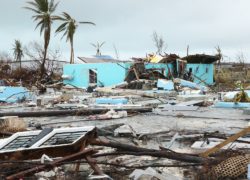
Director of the Pacific Disaster Center Dr. Erin Huey this past Friday insisted there was nothing more the Minnis administration could have done in preparing for a storm of Hurricane Dorian’s size and intensity.
This was said considering the government taking a great deal of flack after the storm ripped through Abaco and Grand Bahama.
“Your building codes are some of the strongest in the Western Hemisphere. Your commitment to disaster management that NEMA and the Family Islands have placed to build disaster resilient communities is really unmatched,” Dr. Huey said.
“So, I think when you’re talking about a really mammoth storm like this, the best thing we could do is help support the people that were impacted. In that respect, I believe very strongly that NEMA has developed quite a robust structure that is able to work with the incoming amount of NGOs in the international community that is supporting. They’re able to absorb it, task them effectively and get the resources out and that is very commendable.”
Furthermore, Dr. Huey said she does not think the challenges experienced in the country are unique.
She said as with any other archipelago or island nation, the biggest challenge right now is getting information, transporting goods from point A to B and tracking individuals to ensure affected persons receive the right level of support.
When asked if she thought mandatory evacuation legislation should be necessary, Dr. Huey said, “The problem is, even in the U.S. and many parts of the world, even those that have mandatory evacuation, you cannot physically force someone to leave.”
“Someone’s attachment to a place is very strong and I think we need to understand the psychosocial components of disasters. There’s a lot of people suffering. They may still have their home, but the trauma of experiencing something like that exists,” she added.
In terms of rebuilding, Dr. Huey said she is unable to give an estimated price tag, as many variables stand in the way.
“It’s going to take a very resilient nation to commit to rebuilding these communities and rebuilding them in a way that is safe and prepared for climate change,” she explained.
Dr. Huey said Dorian is an example of the changing landscape of disaster management.
She added that it illustrates the need not only to rely on historic information, but continued efforts to advance understanding climate change and how it will continue to impact the islands.


